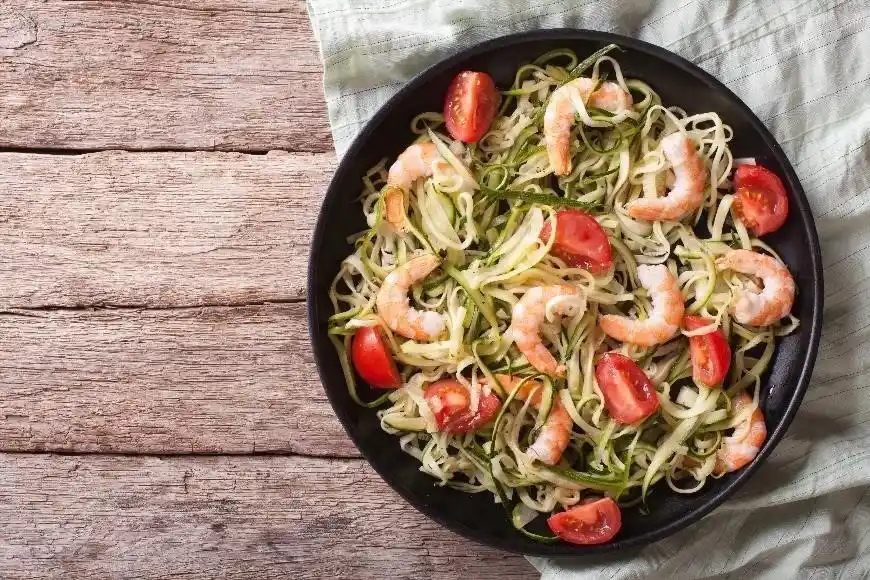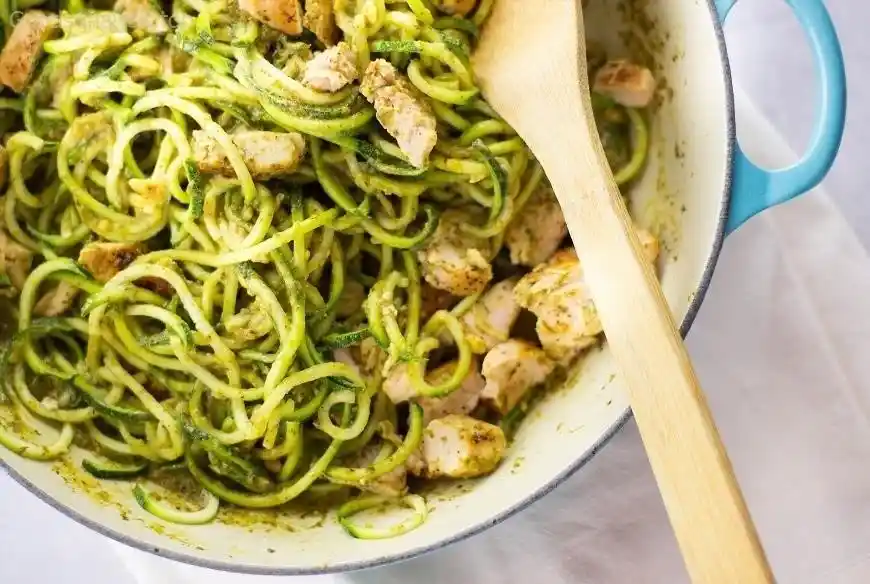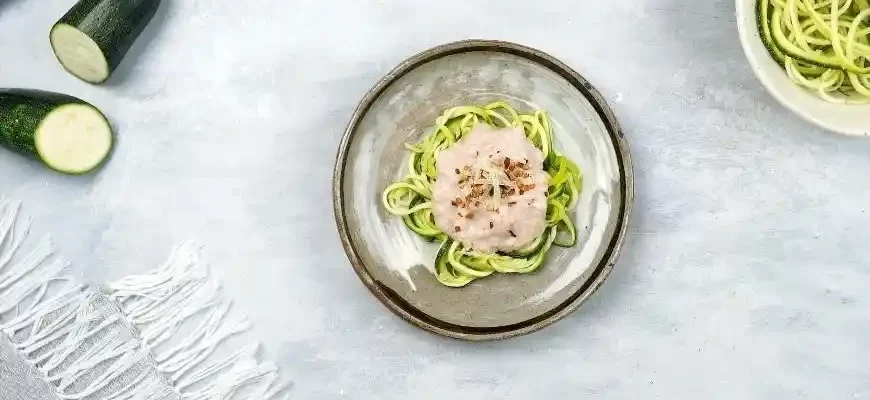Zucchini noodles, or “zoodles,” are a fantastic way to enjoy a low-carb, nutrient-packed alternative to traditional pasta. Whether you’re following a gluten-free diet, aiming to eat more vegetables, or simply looking for a healthier meal option, zucchini noodles are versatile and easy to prepare. But there’s more to them than just being a trendy food. Let’s dive into how to make zucchini noodles, why they are so beneficial, and some tips and tricks to make the experience even better.
Why Choose Zucchini Noodles?
Before we jump into the “how,” let’s quickly touch on why zucchini noodles are a great choice for so many people. Here are a few compelling reasons:
- Low Calorie & Low Carb: Zucchini is naturally low in calories and carbs, making it a great option for those on keto, paleo, or low-carb diets. One medium-sized zucchini has about 33 calories and 6 grams of carbs.
- Packed with Nutrients: Zucchini is rich in vitamin C, vitamin A, and antioxidants. It’s a great source of potassium and magnesium, which are essential for heart and muscle health.
- High in Fiber: Zucchini contains both soluble and insoluble fiber, which helps with digestion and keeps you feeling fuller for longer.
- Versatile: Zucchini noodles can be served raw, sautéed, or even baked. They absorb flavors well, so you can pair them with a wide variety of sauces, meats, and vegetables.
Now that we’ve established that zucchini noodles are more than just a passing fad, let’s get into how to actually make them.
How to Make Zucchini Noodles (Step-by-Step)
Making zucchini noodles at home is surprisingly easy, and you don’t need to be a culinary expert to do it. Here are a few methods, from the simplest to the more advanced.
1. Using a Spiralizer
A spiralizer is the most popular and easiest tool to make zucchini noodles. It’s a small, affordable gadget that turns any vegetable (not just zucchini) into curly, spaghetti-like strands.
Steps:
- Prepare the zucchini: Wash your zucchini thoroughly. Trim the ends off.
- Spiralize: Place the zucchini into the spiralizer and turn the handle. Keep turning until you reach the center of the zucchini, which you can discard or eat as is.
- Use the noodles: You can either eat them raw, sauté them in a bit of olive oil, or use them in a warm dish.

Tip: You can spiralize a batch and store the noodles in the fridge for up to 3 days. They’re perfect for meal prep!
2. Using a Julienne Peeler
If you don’t have a spiralizer, a julienne peeler is a great alternative. It’s a handheld tool that creates long, thin strips of zucchini, resembling fettuccine more than spaghetti.
Steps:
- Prepare the zucchini: Wash and trim the ends off.
- Peel the zucchini: Hold the zucchini with one hand and use the julienne peeler to make long strips.
- Serve immediately: You can eat the zucchini noodles raw, or sauté them in a pan.
This method takes a bit more time but still gives you beautiful, thin noodles.
3. Using a Mandoline Slicer
If you prefer a uniform size and don’t mind a bit more time and effort, a mandoline slicer can create flat, wide strips of zucchini that are great for making “pappardelle”-like noodles.
Steps:
- Prepare the zucchini: Clean and trim the zucchini.
- Slice the zucchini: Using the mandoline, slice the zucchini lengthwise into thin, even strips.
- Cook or serve: These noodles are perfect for lasagna-style dishes or can be sautéed for a simple side.
Pro Tip: You can also slice the zucchini into rounds, then stack and cut into strips for a different texture.
Cooking Zucchini Noodles: Raw or Cooked?
While zucchini noodles can be eaten raw, they are often sautéed or lightly cooked to add flavor and soften the texture. Here are a few methods:

Sautéing
- Heat a little olive oil in a pan over medium heat.
- Add the zucchini noodles and sauté for 2-4 minutes, tossing occasionally. You want them to stay slightly firm, not mushy.
- Season with salt, pepper, and any other seasonings you like. Fresh herbs, garlic, and Parmesan are excellent options!
Blanching
- Bring a pot of salted water to a boil.
- Add the zucchini noodles and cook for 1-2 minutes, just enough to soften them.
- Drain and immediately toss with your sauce or desired ingredients.
Baking
If you’re looking for a baked “pasta” dish, zucchini noodles can be used as a base for lasagna or casserole. Simply layer the noodles in a baking dish with sauce and cheese, and bake at 375°F (190°C) for 20-30 minutes until bubbly and golden.
Common Pitfalls and How to Avoid Them
Making zucchini noodles is simple, but there are a few challenges you may encounter. Let’s tackle them head-on.
1. Zucchini Noodles Are Too Watery
Zucchini has a high water content, which can make the noodles watery and soggy. To prevent this:
- Salt the zucchini before cooking. Sprinkle a little salt on the noodles and let them sit for about 10 minutes. Then, gently press with a paper towel to remove excess moisture.
- Sauté in batches. If you’re cooking a large batch, cook the noodles in smaller portions to allow for better moisture evaporation.
2. Overcooking the Noodles
Zucchini noodles cook very quickly. If you cook them for too long, they can become mushy. Remember, just a couple of minutes in the pan should do the trick!

3. Not Enough Flavor
Zucchini has a mild flavor, so it’s essential to season your noodles properly. Garlic, basil, lemon, and Parmesan cheese all bring out the best in zucchini. Don’t shy away from experimenting with different sauces, such as pesto, marinara, or even a creamy Alfredo sauce.
Zucchini Noodles vs. Traditional Pasta: A Nutritional Comparison
| Nutrient | Zucchini Noodles (1 cup) | Regular Pasta (1 cup, cooked) |
|---|---|---|
| Calories | 20 | 200 |
| Carbohydrates | 4.0g | 43g |
| Fiber | 1.0g | 2.5g |
| Protein | 1.5g | 7g |
| Vitamin C | 20% of DV | 0% |
Clearly, zucchini noodles win on the low-calorie and low-carb front, while traditional pasta offers more protein. So, if you’re looking to cut back on calories or carbs, zoodles are a solid choice. But if you’re looking for more protein or are trying to stick to a traditional pasta craving, there’s no harm in mixing the two together occasionally.
What People Are Saying About Zucchini Noodles
Let’s take a look at what real people—of different backgrounds and ages—think about zucchini noodles:
Sarah, 28, USA:
“I started making zucchini noodles as a way to cut carbs, and now I love them! I use them in everything from stir-fries to soups. My kids even like them!”
Carlos, 45, Mexico:
“Zucchini noodles are okay, but they’re not pasta! They’re a great alternative for health, but if I’m craving spaghetti, I’m sticking with the real thing.”
Anita, 63, UK:
“Since I’ve been on a gluten-free diet, zucchini noodles have been a lifesaver. I use a spiralizer and make all sorts of dishes. They’re great with pesto or even in a salad.”
Daisuke, 37, Japan:
“I like making stir-fried zucchini noodles with soy sauce, sesame oil, and some vegetables. It’s quick and light, but it really satisfies.”
Maya, 52, India:
“I use zucchini noodles in a lot of vegetarian curries. They absorb the spices really well. Just don’t cook them too long—then they become mushy!”
Conclusion
Making zucchini noodles is simple, delicious, and versatile. Whether you’re looking to eat healthier, reduce carbs, or just add some variety to your meals, zucchini noodles are a fantastic option. Keep in mind the tips and tricks to avoid common pitfalls like excess water or overcooking, and don’t be afraid to experiment with different sauces and seasonings to make them your own.
So, grab a zucchini (or three), and start spiralizing! Your body—and taste buds—will thank you.









